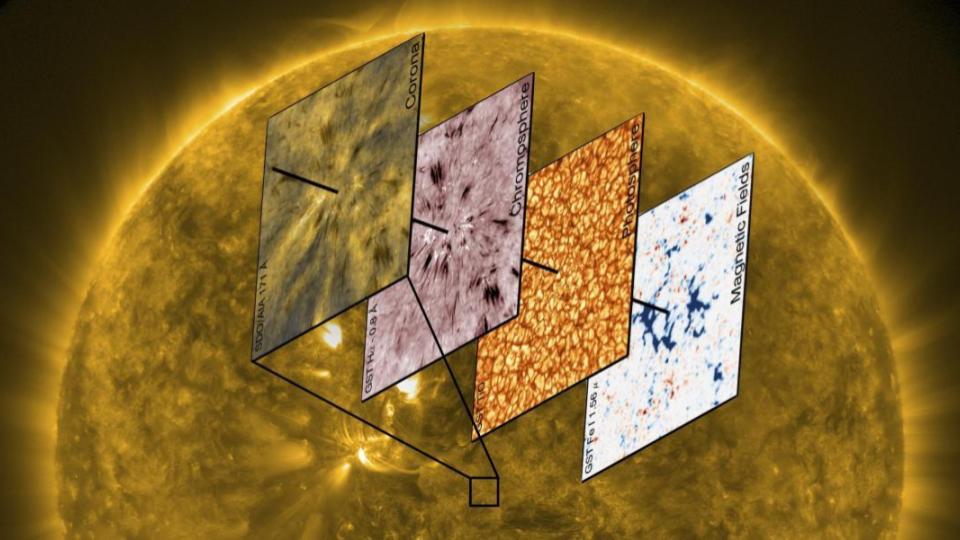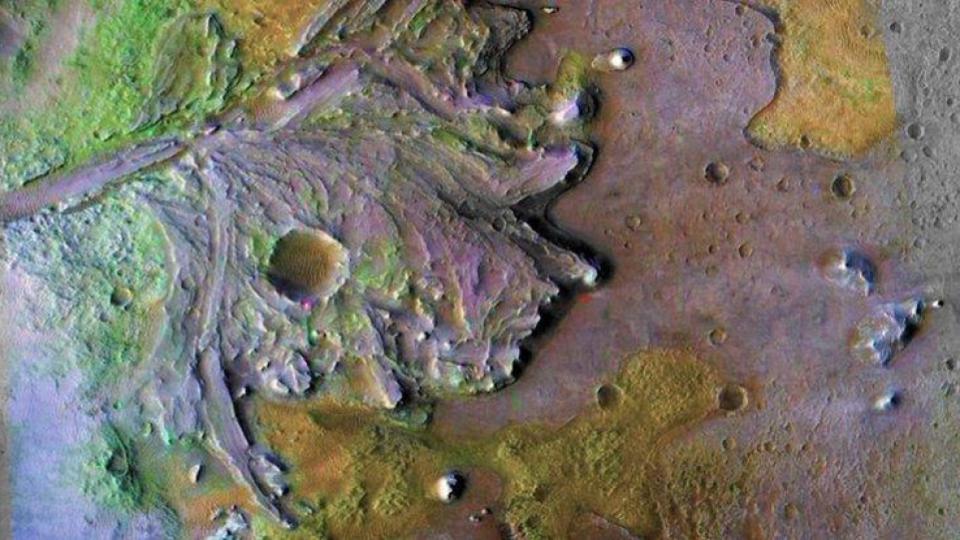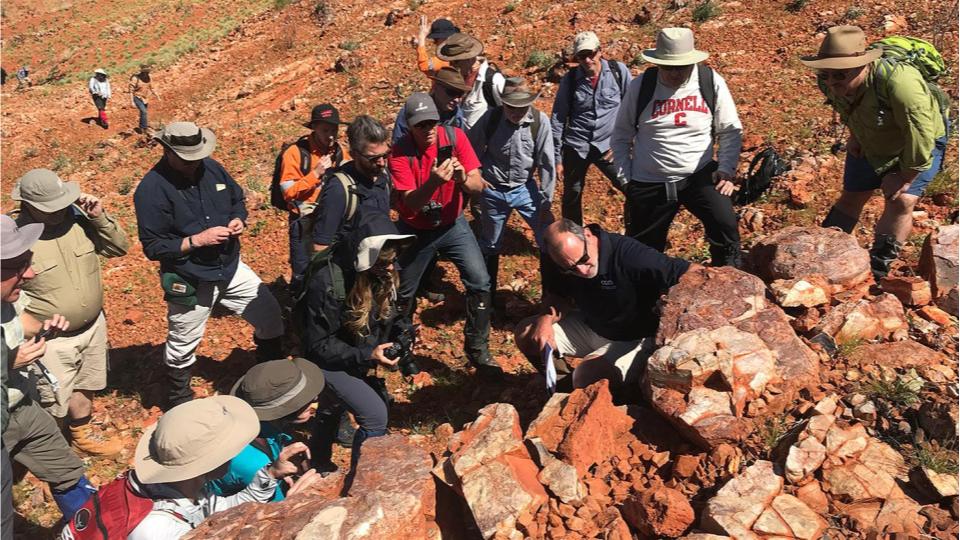Today’s episode takes a hard look at two of our solar systems deeper mysteries. The first story looks at our Sun and resolves a possible source for how superheated spicules form and maybe heat the corona. Our second story looks at how Mars 2020 (and ExoMars) will be looking for fossilized life on Mars, what this means, and how they’re preparing by looking at fossilized life on Earth
Here in North America, we have less and less Sun everyday, but while our sky may be winter grey, the most recent episode of Science has all the Sun you can take.

- Images from NJIT Big Bear Solar Observatory Peel Away Layers of a Stellar Mystery (Press Release)
- Generation of solar spicules and subsequent atmospheric heating (Science)
- A Million Geysers of Plasma Spout from the Sun, and Scientists May Finally Know Why (Space.com)
One of the great questions in Solar astronomy is how energy is transported from the surface of the Sun to the Corona. We’ve known for many decades that the surface of the Sun is about 6000K, while the expansive Corona is more than 1million Kelvin. How something gets hotter with distance is brain breaking. Possible explanations of this inversion of expectation have been published year after year and I don’t know if the paper I’m about to describe will be part of the final answer, but it is one that is worth paying attention to.
According to a paper led by Tanmoy Sarnanta and Hui Tian of Peiking University, this energy transport is rooted in a process driven by magnetic fields. In 1877, small geyser like structures were discovered all over the surface of the Sun. Called Solar Spicules, these features form a forest of magnetized plasma.These structures are thought to somehow be responsible for the corona’s heating, and perhaps even for the generation of the plasma in the solar wind, but what generates these spicules has been its own mystery.
Now, using an impressive combination of solar observatories, this team thinks they’ve uncovered the spicules source. According to the press release, “Their observations argue that the dynamic interaction of magnetic fields with different polarities is responsible for the generation of many spicules.” Let’s break that down. If you’ve ever played with magnets, you may have noticed that they can either attract or repel each other, depending on their orientation. These different ways of interacting are referred to as their polarity. When we observe the Sun we see emerging magnetic field lines of both polarities, and this paper notes that spicules tend to emerge where new features of one polarity emerge in a region that had been dominated by the other polarity. This coming together of magnetic field lines of different polarities is called reconnection. This appears to be a gradual process, and this research describes a “ general progression of events leading to spicules: Weak magnetic fields appear frequently near the existing large-scale network fields. Occasionally, small-scale weak fields of polarity opposite that of the network will grow outward and migrate toward the network, where they reconnect with the adjacent or overlying network field in the upper photosphere or low chromosphere, and this produces the spicules.”
Once the spicules are in place, they are observed to have temperatures comparable to that of the corona, and they eject this super heated plasma at speeds of 100 km per sec.
This research pushed what is possible with modern telescopes. From the mountains outside LA, solar physicists used Big Bear Observatory to take images every 3.5 seconds that could resolve ~45km features on the sun. These ground based observations were coupled with Solar Dynamic Orbiter observations of the Corona’s ultraviolet emission. Now, solar physicists are working to build computer models that will allow a coherent picture of the Sun to be virtually assembled that traces energy from its point of generation in the solar core and outwards to where it superheats the corona.

- NASA’s New Mars Rover Is Going to a Place Perfect For Preserving Fossils (Science Alert)
- NASA’s Mars 2020 Will Hunt for Microscopic Fossils (JPL)
- Scientists gear up to look for fossils on Mars (Astronomy)
From the complexities of solar physics we’re know going to completely switch topics and look at the complexities of life. If you use social media or read science news online, you may have noticed several click-baity titles lately, about how the Mars 2020 rover is going to go Fossil Hunting on Mars. As someone who has frequently given talks with that exact title, I can’t slight folks for using that phrase, but I do think that care needs to be taken to not oversell what the Mars 2020 rover is trying to do.
Hopefully launching sometime next year, this next US rover will land on Mars in 2021 and explore Jezero crater and river delta. It is hoped that this region will contain ancient organic molecules, and for the very hopeful among us, this region also has the same kind of geology – a carbonate rich layer – that we know can preserve fossils here on Earth. Since this region clearly used to have water, and has the kind of soil that can hold fossils, it’s considered the best possible place to look for fossils.
The catch is, we don’t entirely know what we’re looking for. It would be amazing if the Rover could rove up to a wall of sedimentary layers and see fossilized sea shells and stromatolites, and corals all clearly and indisputably visible. It’s that second word – indisputable – that we need to worry about. There are those who fervently believe that the Viking missions in the 1970s found evidence of present day life, but because the results weren’t indisputable, and because extraordinary claims require extraordinary evidence, it is generally said that life hasn’t been found on Mars. Even here on Earth, there is debate around whether some stromatolite looking formations in Australia are truly ancient bacterial mats, or if they could be the result of some other, non-biological, process. If the Mars 2020 rover sees some things that kind of sort of look like life, as formations in a Mars meteorite, Allan Hills 84001, look kind of sort of look like life, skeptics will be able to say “nope – nothing to see here but plain old rock.” Making things even more complicated, if fossilized life on Mars looks like nothing we can anticipate, will we be able to recognize it at all?
Basically, what I’m trying to say, is Mars 2020 is going to a super cool place on Mars. It has all the potential in the world to find fossilized life if there are such fossils to be found, but even if it does find fossilized life, I wouldn’t expect a NASA press release announcing the discovery without a whole lot of use of the word “possible” and there will be alternative explanations in all likelihood, and … well… extraordinary claims will require extraordinary evidence that this rover likely can’t provide on its own – it’s going to need a little help from a friend. Mars 2020 is designed to be able to pick up samples can carry them away to be loaded up for return to Earth someday in the future. And maybe, in that future, we will be able to say – Yes – that is a fossil of something that lived.
While not making the same headlines as Mars 2020, the EU’s ExoMars (or Rosalind Franklin Rover) has the same fossil finding potential, and its team are more quietly just as anxious to find life.

- Mars Scientists Investigate Ancient Life in Australia (JPL)
- Mars scientists investigate ancient life in Australia (Phys.org)
- Mars Science Teams Investigate Ancient Life in Australia (JPL video on YouTube)
Lots of folks really want life to be found, and they are trying to make the discovery process as straightforward as possible. This means going to the oldest landmasses on Earth and poking them with scientific instruments to see if we can find evidence of our world’s oldest life forms. The two oldest places on Earth are the Canadian shield and Western Australia, and Australia has often proved itself to be a source of weird ancient fossils. In preparation for Mars 2020 and ExoMars, scientists from both teams have traveled to the Pibara region of Western Australia to explore the fossilized signs of ancient life. Working with fossil experts, they are learning to recognize stromatolites, and ancient microbial life. To the untrained eye, the rocks in the Pibara region are just rocks – but to the trained eye its possible to see how life on Earth began so many billion years ago. By training their human eyes on what we can see on Earth, these Mars focused scientists hope to be able to better understand what their rovers’ robot eyes are seeing on the Red Planet.
Assuming these missions make it past the Mars curse and are able to safely rove their two potential fossil beds, the next few years are likely to rich in amazing headlines, and we plan to be here, bringing you the science behind the click bait as life maybe is and maybe isn’t found else where in our solar system.
——————–
That rounds out our show for today.
Thank you all for listening. The Daily Space is produced by Susie Murph, and is a product of the Planetary Science Institute, a 501(c)3 non profit dedicated to exploring our Solar System and beyond. We are made possible through the generous contributions of people like you. If you would like to learn more, please check us out on patreon.com/cosmoquestx During the month of November we are running a special fundraiser to support our server costs for 2020. We project costs of $1450 for all of our websites. If you would like to help us reserve our place on the internet, you can donate at streamlabs.com/cosmoquestx. Your donations are tax deductible where allowable in the world.
Each live episode of the Daily Space is archived on YouTube. If you miss an episode here on Twitch.tv, you can find it later on youtube.com/c/cosmoquest. These episodes are edited and produced by Susie Murph.
We are here thanks to the generous contributions of people like you who allow us to pay our staff a living wage. Every bit, every sub, and every dollar committed on Patreon.com/cosmoquestx really helps. If you can’t give financially, we really do understand, and there are other ways you can help our programs. Right now, the best way you can help is to get the word out. Let you friends know, share our channel to your social media, or leave a recommendation. You never know what doors you are opening.


 We record most shows live, on Twitch. Follow us today to get alerts when we go live.
We record most shows live, on Twitch. Follow us today to get alerts when we go live.